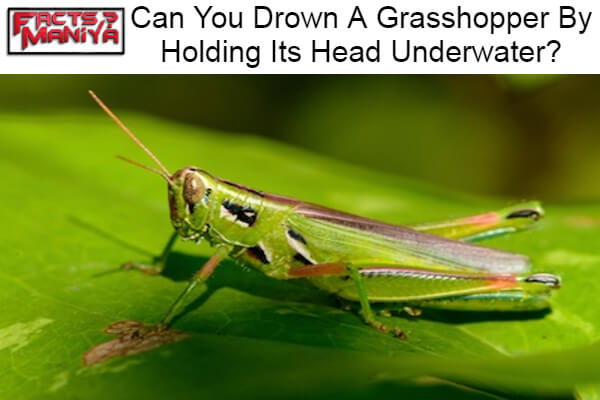Have you ever thought about Can You Drown A Grasshopper By Holding Its Head Underwater? There are typically ten, five on each side of the body, in grasshoppers. The majority are along the abdomen, with one group on the thorax.
These spiracles enable gas exchange and transport air to the trachea, a system of long tubes that travel through the body. These inhale the gas and discharge it into the tracheoles, branches that permit grass exchange feeding the air into muscles.
These function similarly to the lungs’ branch-like structures. The abdominal muscles are what contract to circulate air throughout the body. If you wanted to drown one, you would need to hold its thorax and abdomen under water.
Can you drown a grasshopper by holding its head underwater?
No component of a grasshopper’s head is used for breathing. Grasshoppers breathe through a multitude of openings called spiracles that are located along their thorax and abdomen.

Grasshoppers Have Exoskeletons For What Reason?
A grasshopper’s exoskeleton shields its soft tissue and supports the body’s structural integrity.
Can Grasshoppers Become Suffocated?
They are not known to devour human flesh, so while they might be able to suffocate an unconscious person, they wouldn’t be a hazard when they were up.
Grasshoppers Can Drown; Why?
The parasitic nematomorph hairworm Spinochordodes’ larvae grow inside grasshoppers and crickets. Once the parasite has matured, it induces its host, a grasshopper, to jump into the water, where the grasshopper would probably drown. This parasite has this power over its host.
What Purpose Does The Exoskeleton Serve?
Exoskeletons are made up of strong, rigid parts that serve various functions in animals. These functions include defense, elimination, sensing, support, feeding, and functioning as a barrier against desiccation in terrestrial species.
Is There An Exoskeleton On Grasshoppers?
Invertebrates like grasshoppers have skeletons. This implies that they lack a backbone (no spine). They possess an exoskeleton, which is their external skeleton. An endoskeleton protects us.
Insects Have Exoskeletons For What Purpose?
The insect’s exoskeleton shields its internal organs, keeps them from drying out, attaches to its muscles, and enables the insect to observe its surroundings. Understanding these exoskeleton advantages helps illuminate why it makes sense for insects to have a skeleton that is external to the body.
What Benefits Do Exoskeletons Offer?
Exoskeletons are made up of strong, rigid parts that serve various functions in animals. These functions include defense, elimination, sensing, support, feeding, and functioning as a barrier against desiccation in terrestrial species.
If The Grass Floods, Do Earthworms Drown?
Some do; after heavy rains, I’ve noticed dead earthworms in my driveway and the sidewalks. Most underground species have tunnels built as a safe zone during rain, but occasionally there may be too much rain and a. If their tunnels flood, they will rise to the surface, but if there is also standing water on the land, they may perish.
Can A Person Drown Peacefully?
Briefly, yes and no. When a person starts to drown, they are fighting to break the water’s surface while holding their breath, fighting acute apnea the overwhelming urge to breathe. That is the distressing and unpleasant part of drowning.
Apnea eventually triumphs, and the response to breathing becomes automatic. The water initially hurts and makes you cough, but eventually, the lungs fill with water, and you can breathe it in and out like air. However, because your lungs are not gills, you cannot oxygenate your blood. Despite knowing this, you won’t feel any physical discomfort like when you had apnea.
Until you pass out, all you will do is gently breathe in and out water. You hear it is tranquil because of this. A struggle, the cessation of suffering, a few closing reflections, and then sleep. In other words, while drowning itself is quite tranquil, fighting your natural impulse to breathe before it happens is terrible.
I have experience underwater using scuba as a professional diver. I’ve managed to survive numerous instances where the only thing keeping me alive was a backup system. Fortunately, I have always survived. But each time I fail, it reminds me of a course of action I can take if I reach the breaking point.
I have decided that if I drown, I will take my final breaths while mentally performing the memories I hold dearest. I will control my breath until I have performed to the best of my ability, at which point I will remove my regulator and take one final breath.
I will then think of a specific dive I took with my wife and admire its grandeur one last time before I pass away. Probably to Hey Jude’s music, though that hasn’t been decided yet. I don’t know how other people in hazardous professions handle the idea of dying in it, but that is my experience.
Conclusion
Here is my final say about Can You Drown A Grasshopper By Holding Its Head Underwater? Strong constriction and valves can build up a coordinated flow of air. The mouth is not how creepy crawlies breathe. In a similar vein, keeping a creepy-head crawly’s underwater won’t cause it to suffocate.
Sometimes creepy crawlies draw air via their mouths for purposes other than calming down. Since they lack lungs, grasshoppers cannot breathe through openings on their heads. They breathe through spiracles on their sides, microscopic openings, and passageways that deliver air to their muscles and the rest of their tissues. That’s what the one I dissected in biology did, at least.

